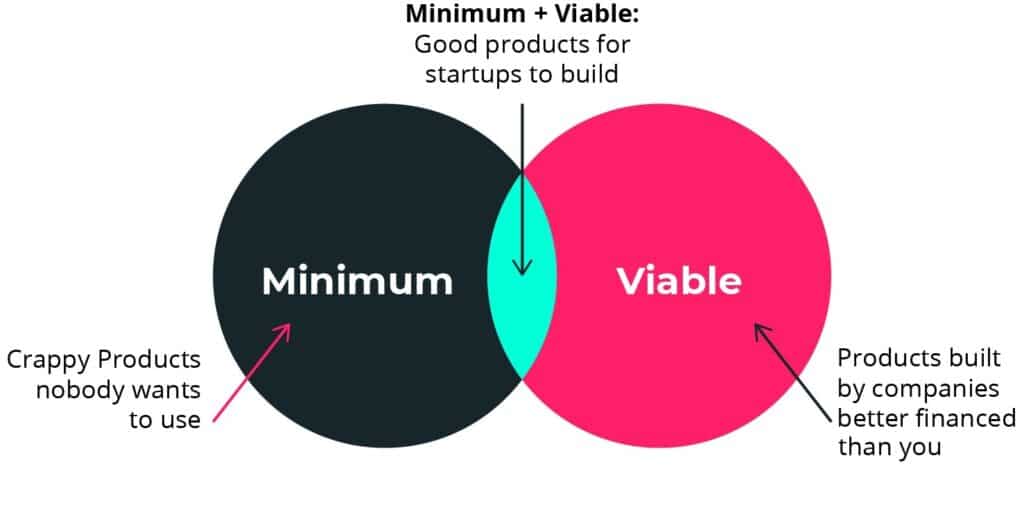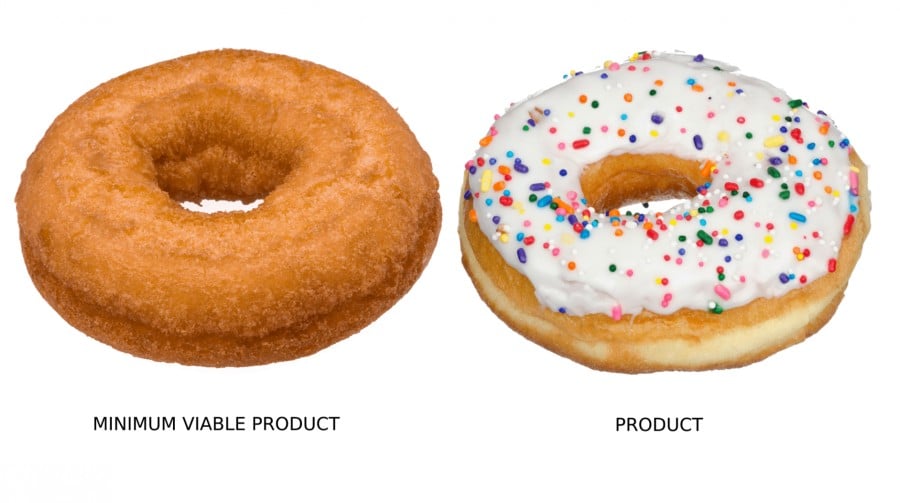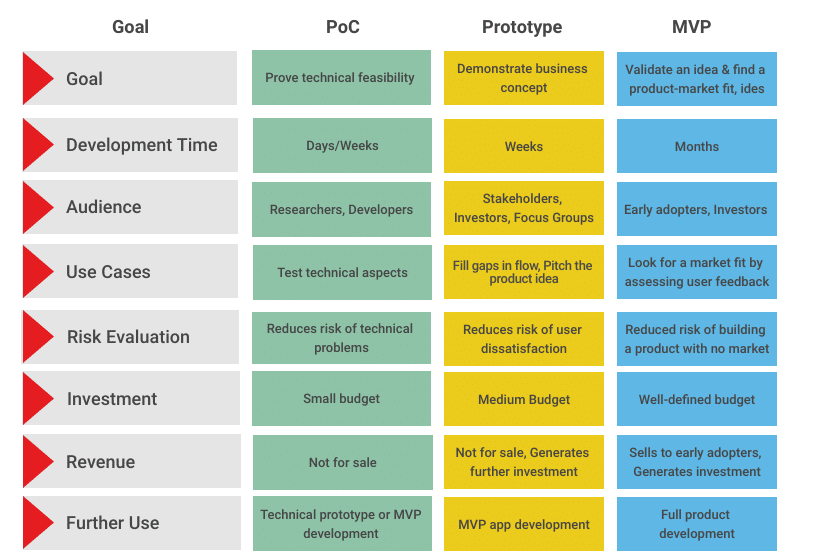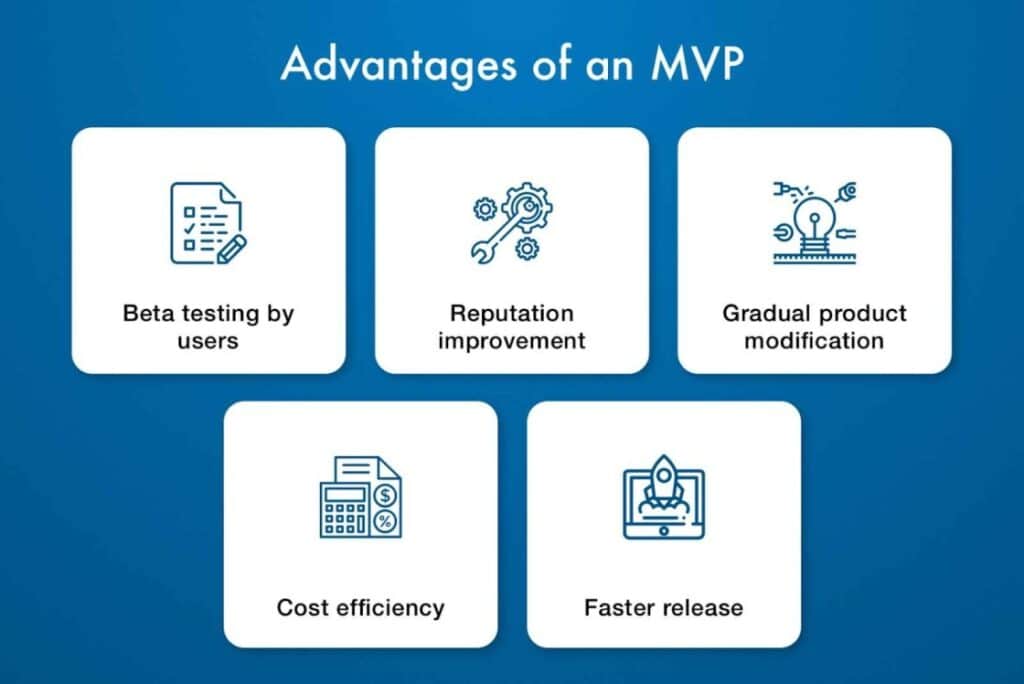MVP Software Development: A QuickStart Guide to Success
“In the journey of software development, an MVP is the compass that guides us to success, with its simplicity as our North Star and user feedback as our constant companion.”
In custom software engineering services, a Minimum Viable Product (MVP) is a basic version of a product that includes only the essential features required to solve a problem for its target users. An MVP allows developers and entrepreneurs to test their assumptions about a product’s value proposition, gather user feedback and iterate on the product before committing to full-scale development.
MVP in software development is significantly important for startups businesses because it is a cost-effective and efficient way to validate product-market fit, reduce time to market and minimize the risk of failure. By focusing on core functionalities, it helps to allocate resources wisely, gather customer feedback, and make data-driven decisions to improve product over time.
What is an MVP in Software Development?
An MVP, or Minimum Viable Product, is a version of a product with essential features necessary for its release to early customers. The primary goal of MVP software development is to gather valuable feedback and insights to better understand market demand while minimizing costs and managing risks.
In accordance with the lean startup methodology, validating a fully-fledged product can be expensive and time-consuming for a development team. An MVP contains the core functionality required to satisfy early adopters and collect feedback, which helps guide the development process. Essentially, it is an experiment designed to test a potential solution to users’ problems and determine if the proposal is viable from a business perspective.

As Eric Ries describes,
“The minimum viable product is that version of a new product which allows a team to collect the maximum amount of validated learning about customers with the least effort.”
MVP software development involves creating software that possesses the minimum features required for the product to be viable. This approach states the core functionality of the product and allows for its initial release to customers without any unnecessary extras. Building the basic framework, testing its functionality and ensuring successful delivery serves as the foundation for credibility. The final application will be grounded in user experience and feedback.
Incorporating the agile methodology, MVP development allows for a phased product release, which greatly reduces the likelihood of failure while saving time and costs. Customer-driven changes can be incorporated through the iterative process of building, measuring, and learning to ensure that market needs are thoroughly met.
Minimum Viable Product Development: Goals and Objectives
A minimum viable product (MVP) represents the most basic version of the software that can be shipped, typically containing only the crucial feature set to resonate with your target audience. The primary objective of MVP development is to gather valuable feedback from users and begin generating returns early. After launching an MVP, it can be improved with new features until it evolves into a full-fledged app.
Delivery time ranges from 3 weeks to 8 months, with development stages taking between 5-10 days (for no-code/low-code development) and 6 months (for code-based development).
Costs can be from $30,000–250,000+, accounting for 10–40% of the total software cost. Amplework specializes in designing and building high-quality MVPs for over 40 industries, offering comprehensive consulting services at any stage of your MVP software development project.

Eric Ries, the pioneer of the MVP concept within his Lean Startup methodology, defines its purpose as enabling a team to gather the maximum amount of validated learning about customers with minimal effort. Companies might opt to develop and launch an MVP to bring a product to the market swiftly, test an idea with real users before allocating a substantial budget to the product’s full development, or identify aspects of the product that appeal to their target market. Apart from validating a product idea without building the entire product, an MVP can also help minimize the time and resources spent on developing a product that may not succeed.
MVP Software Development, PoC and Prototypes Each Have A Distinct Purpose:
Proof of Concept
A Proof of Concept (PoC) is typically created during the pre-product stage as an internal project. Its goal is to validate the feasibility of an idea and confirm that it can be realized from a technical standpoint.
MVP
On the other hand, an MVP is generally a high-quality, fully functional product designed to help determine market fit. It allows developers to gauge whether customers desire the product and, ultimately, if they are willing to pay for it.

To understand how PoCs differ from prototypes and MVPs, read our blog post on Prototype vs MVP vs PoC.
Why Build an MVP – Key benefits?
An MVP is a basic version of the software that includes core features and benefits software development because of it:
- Validates product ideas early.
- Enables quicker launches with smaller budgets.
- Tests product ideas in the market.
- Reduces inefficiencies and speeds up feature releases.
- Minimizes errors during development.
- Helps match offerings to customer needs.
- Provides valuable data for data-driven decisions.
- Facilitates pre-launch customer base growth.

To achieve these benefits, the MVP Software development process involves verifying the product’s effectiveness, ensuring market demand, gathering user feedback and launching with speed. It helps in avoiding wasted resources and building a pre-launch user base.
Read about: MVP Development Questions & Answer
MVP Software Development Statistics
Success in startups has often been linked to how quickly they grow. However, it’s been found that growing too quickly can be a major cause of startup failure, with over 70% of cases being attributed to premature scaling. In other words, trying to expand too fast without enough groundwork and planning can be a recipe for disaster. I Developing an MVP app can help reduce the risk of failure over the long term. NMG reported that 80% of apps have a survival rate of fewer than 12 months.
Startup failures often result from the following:
- Misunderstood or under-researched market needs (40%)
- Budget constraints (30%)
- Stronger competition (20%)
- Marketing, pricing, or design issues (10%)
To avoid these pitfalls and successfully bring a project to fruition, MVP development can be an effective strategy. Let’s explore what a minimum viable product is and how to create an MVP that is effective.
Key Principles of MVP Development
A. Focus on Core Features
When developing a successful MVP, it’s crucial to pinpoint and prioritize the most critical features that directly address the problem your product aims to solve. Concentrating on core features guarantees that your MVP delivers value to your target users, setting a robust foundation for future product development.
B. Simplicity and User-Friendliness
An MVP should be straightforward, intuitive, and user-friendly. By emphasizing user-friendliness throughout the design and development process, It enhances the user experience, leading to increased satisfaction and adoption rates. We can help you by implementing user-centered design principles, conducting usability tests.
C. Iterative Development and Feedback
MVP development should follow an iterative process that allows for continuous improvement based on user feedback and performance metrics. Regularly integrating user feedback and making data-driven decisions will help you fine-tune your product to meet the needs and expectations of your target audience. MVP for mobile app development, consider partnering with Amplework to ensure a successful MVP that serves as a solid foundation for your product’s future growth.
Steps to Develop a Successful MVP Software
1. Identify your target audience for MVP
Conduct market research and create user personas to define your target audience. Understanding your users’ needs, preferences, and pain points will help you design an MVP that addresses their specific requirements and provides value.
Discovery and MVP Planning:
- Business Analysis: Product idea generation, target market, customer, and competitor research. Developing a product concept, monetization strategy, and KPI dashboard for MVP.
- Feature Road-mapping: Outlining and prioritizing features for the full software version.
- MVP Architecture Design: High-level design of the final solution, performance requirements, and information security considerations.
- Compliance with regulations: (e.g., HIPAA, FDA, PCI DSS) if needed.
- Planning MVP Integrations: Integrating with third-party systems if necessary.
- Choosing a Technology Stack: Choosing required technology stack for MVP software development.
2. Define your value proposition
Clearly articulate the unique value your product offers to your target audience. Your value proposition should be concise and demonstrate how your product solves a problem or fulfills a need for your users.
3. Prioritize essential features
Determine the most important features for your MVP by analyzing your target audience’s needs and expectations, as well as the problem your product aims to solve. Prioritize these features for development and ensure they align with your value proposition.
You probably have a clear idea of the features your product needs. The key points is to prioritize these features based on user stories or user scenarios, distinguishing between essential and desirable features. The objective is to pinpoint the critical functions for MVP software development that deliver the core value proposition.
For instance, the focus of an MVP for a simple ecommerce website would be on the necessary steps customers need to complete a purchase:
- Register an account
- Select a product category
- Access the page
- Press a buy button to purchase a product
- Complete the checkout process
- Subsequent features can be incorporated later.
4. Develop a solution prototype
Avoid overlooking this crucial step. An interactive demonstration of the idea aids in mapping out user flow, estimating MVP software development costs, and gathering preliminary feedback. It is also beneficial in a sales environment.
By using UX tools like AdobeXD, Figma, Zapline, Miro, or Axure to create prototypes. Some of these tools offer free pricing options Once the prototype is completed, present it to early adopters to gauge their interest in the product.
5. Develop and test your MVP
Develop your MVP using Agile development methodologies, which enable flexibility and quick adaptation to changes. Test the MVP thoroughly to ensure it functions as intended, is user-friendly, and meets your target audience’s needs.
No-code MVP development
No-code MVP method ideal for startup MVPs or SaaS MVPs, No-code MVP development is a process of creating a minimum viable product without writing any code. It aims to test demand for a product or app’s functionality using minimal resources and investment, like In some cases, businesses can assess demand using free online tools and minimal resources, such as creating a landing page with a product description or video and a call-to-action button (e.g., collecting email addresses from interested parties) or manually performing behind-the-scenes processes to simulate automation.
Occasionally, it’s possible to test demand for a new product or app’s functionality without coding and minimal investment. Amplework employs MVP types such as:
- Landing page MVP (for products): Presents an upcoming product on a landing page using text, video, wireframes, or live prototypes. This approach gauges demand through requests or sign-up forms and helps prioritize app development based on feature interest.
- Flintstone MVP: Promotes new software and its future automation capabilities, while temporarily managing processes manually.
Examples include Dropbox, which gained positive feedback and funding by creating a short video demonstrating their product’s full functionality without building anything initially, and Zappos, whose founder tested online shoe sales by posting photos of shoes from local stores and personally purchasing them after receiving an order.
Code-based MVP development
Code-based MVP development is the process of creating a minimum viable product with essential features by writing actual code. This approach focuses on delivering the core value proposition of the product or app while keeping development time and costs minimal.
- Single-feature MVP: Implement the key points/feature for core value.
- Piecemeal MVP: Develop a product using pre-existing components, updating or replacing them later.
Amplework’s process includes:
- Design user personas and journeys for an intuitive app experience.
- Create custom designs for user-facing elements (only if the design is a competitive advantage).
- Utilize ready-to-use cloud components (primarily AWS and Azure) for back-end and front-end development.
- Conduct testing in parallel with development.
- Deliver a working MVP with supporting documentation.
Hire MVP Software Developers
This widely used approach of hiring developers requires caution to avoid poor hiring decisions. Platforms like Upwork or Freelancer can assist in finding freelance software engineers and providing developer ratings, project descriptions, and client feedback. However, some technical knowledge is important for candidate vetting, as hiring freelancers involves risks.
A more reliable option is partnering with an experienced IT agency that can also provide valuable consulting and CTO services. They can quickly assemble a project team, including a business analyst, UX/UI designers, developers, and testers, taking care of recruitment. From market research to feature planning, MVP architecture design, tech stack selection, and testing, all your technology requirements will be met.
Clutch, AppFutura, and GoodFirms are excellent resources for finding the right technical partner. Alternatively, you can request our MVP development services—our skilled developers team has delivered numerous successful products for startups and enterprises across various industries.
6. Launch and Keep iterating
Launch your MVP to a limited audience or through early-access programs. We deploy ready-to-use software to the production environment, first moving complex MVPs through testing and staging environments to safely introduce final changes and catch any remaining issues. After the release, we encourage users to provide feedback and monitor user behavior to gather insights that will inform future iterations with the MVP, validating or redefining user stories, identifying risks and updating the risk management plan, and adjusting features. Upon market validation or positive changes in business processes, we either further evolve the MVP or build new software from scratch to cater to the needs of a growing user base.
MVP Development Costs
Developing custom MVP software can range from $30,000 to over $250,000, accounting for 10-50% of the overall development cost. The investment in an MVP can vary based on the type of software and its complexity: Here are the estimated costs for creating an MVP (Minimum Viable Product) for different types of applications:
Mobile MVP:
- Cost range: $20,000 to $130,000
- Mobile MVPs are typically developed for iOS or Android platforms
- The cost can vary depending on the complexity of the app, its features, and the development team’s experience
Web Portal MVP:
- Cost range: $25,000 to $140,000
- Web portal MVPs are developed for web browsers
- The cost can vary depending on the complexity of the portal, the number of features, and the development team’s experience
SaaS MVP:
- Cost range: $30,000 to $250,000
- SaaS MVPs (Software as a Service) are typically web-based applications that provide a service to customers.
- The cost can vary depending on the complexity of the software or web apps, the number of features, and the development team’s experience
Each project is estimated individually based on the customer’s specific needs and circumstances. The total cost of MVP development depends on numerous factors.
At Amplework, we identify the most critical cost factors as:
- Application type (web, mobile, desktop) and the number of platforms supported (for mobile).
- Number and complexity of features.
- Uniqueness and complexity of the design.
- Number and complexity of integrations with third-party systems.
- MVP performance, availability, security, latent capacity and scalability requirements.
- The need to maintain existing data (for custom enterprise software MVP in case of migration).
Amplework can help you estimate the costs of your specific MVP project to establish a reasonable budget.
Read about: Importance of MVP in Mobile Application Development
Successful MVP Examples & Case Studies
Many well-known applications began as MVPs. Instagram, for instance, initially focused on location-based check-ins, similar to Foursquare. As the photo-sharing feature gained popularity, the app transformed into a full-fledged social media platform with over 1.4 billion users worldwide.
Spotify:
Case study Spotify is another example. In 2008, founders Martin Lorentzon and Daniel Ek identified the music industry’s limitations in streaming songs. They launched an MVP to enable artists to stream music online, and the lean startup approach quickly validated the idea, paving the way for the feature-rich platform we know today.
Airbnb:
Airbnb began as a straightforward website that enabled people to rent out their homes or rooms to travelers. The initial MVP concentrated on the core functionality of connecting hosts and guests, which allowed the company to validate its business model and collect valuable user feedback to enhance the platform. The platform grew as travelers embraced staying in others’ homes to save on accommodation costs.
Facebook:
Facebook began as a basic social media tool for connecting with friends at Harvard University. As the idea gained popularity, the platform expanded and added more complex features.
Food on the Table:
Food on the Table, a concierge MVP, initially had founder Manuel Rosso manually selecting recipes, creating shopping lists, and finding coupons. As user feedback confirmed the model’s viability, an automated process was established.
Dropbox:
Dropbox’s first MVP was a demo video that demonstrated the product’s core features and functionality. This approach enabled the company to gauge interest and gather feedback without investing in developing a full-featured product. The positive response from users led to the creation of the well-known file-sharing platform we use today.
Uber:
Uber’s MVP originated as a basic mobile app focused on connecting riders and drivers in San Francisco. By emphasizing essential features like booking and payment, Uber could validate its business model, gather user feedback, and expand its service to other cities and countries.
Buffer:
Buffer, before developing its app for scheduling social media posts, launched a series of landing pages. The pages gauged interest in plans and pricing for the product. When most users opted for paid plans, it became evident that Buffer had potential.
Common Pitfalls and How to Avoid Them
A. Over-engineering
Over-engineering occurs when an MVP includes too many features or complexities, which can cause delays and increase development costs. To avoid over-engineering, focus on the core features that address the primary problem and prioritize simplicity.
B. Ignoring user feedback
Ignoring user feedback can lead to the development of a product that does not meet the needs of your target audience. To avoid this pitfall, actively seek user feedback, analyze it, and make data-driven decisions to improve your MVP.
C. Poor market research
Insufficient market research can result in an MVP that does not address a genuine need or problem. To avoid this, conduct thorough market research and competitor analysis to identify opportunities and validate your product’s value proposition.
Tools and Technologies for MVP Development
Agile development methodologies
Agile development methodologies, such as Scrum and Kanban, enable flexibility and quick adaptation to changes. These methodologies prioritize iterative development and continuous improvement, making them well-suited for MVP development.
Popular software frameworks and libraries
Using established software frameworks and libraries, such as React, Angular, and Ruby on Rails, can speed up MVP software development and ensure the use of industry-standard best practices.
Project management tools
Project management tools like Trello, Asana, and Jira can help organize and streamline the development process, ensuring efficient collaboration among team members.
How to measure the success of MVP?
A. Key performance indicators (KPIs)
KPIs are essential metrics that help you gauge the success of your MVP. Examples of KPIs include user acquisition, retention, and revenue growth. Monitoring KPIs enables you to make data-driven decisions for product improvement and growth.
B. User engagement metrics
User engagement metrics, such as session duration, bounce rate, and active users, provide insights into how users interact with your MVP. Analyzing these metrics can help you identify areas for improvement and enhance the user experience.
C. Feedback analysis and improvements
Analyzing user feedback is crucial for understanding user needs and expectations. Use feedback to identify areas for improvement, address user concerns, and prioritize future development efforts.
Read more: MVP Case Studies: Lessons Learned from Successful Companies
Scaling Your MVP to a Full-Fledged Product
Enhancing features based on user feedback
As you gather user feedback and analyze performance metrics, use this information to enhance and expand the features of your MVP. This iterative process ensures your product continues to meet user needs and expectations.
Building a strong development team
As your product scales, you will need a capable MVP development team to support its growth. Invest in hiring talented developers and provide them with the resources and tools needed to succeed.
Marketing and growth strategies
Develop and execute marketing and growth strategies to increase user acquisition and retention. Utilize channels such as content marketing, social media, and public relations to create awareness and drive the adoption of your product.
Conclusion
In conclusion, the key to a successful MVP is focusing on core features, prioritizing simplicity and user-friendliness, and following an iterative development process. Regularly gathering user feedback and making data-driven decisions will ensure your MVP evolves into a full-fledged product that meets user needs and expectations.
By adhering to the tried-and-true practices and strategies discussed in this MVP software development guide, you’ll significantly improve your chances of developing a thriving MVP, and ultimately, a prosperous product. With amplework, you will gain the knowledge, resources, and backing necessary to ensure your MVP’s success.
At Amplework, the leading MVP development company that take specific market measurements to deliver a MVP solution to clients. It’s crucial to remain attentive to your target audience, consistently gather and examine user feedback, and base your decisions on data throughout the development journey. Our MVP solutions will lay down a strong foundation for ongoing success with determination, commitment and the valuable help of Amplework.


 sales@amplework.com
sales@amplework.com
 (+91) 9636-962-228
(+91) 9636-962-228





